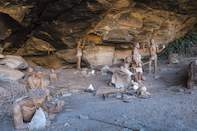The Planets Oldest Human Culture
As far as we can tell, the Bushmen have been here for the last 25 000 years and probably even longer. They are the oldest identifiable human culture on the planet and, consequently, also one of the most abused. But, at first, they were part of a perfectly balanced world.

Drakensberg Mountain Bushmen
In the beginning, there were no other humans in the land. There were only the wild plants, the wild animals and the small, dark Bushmen who hunted and gathered for their food.
With no political borders to inhibit their freedom, and no other humans with which to compete, the Bushmen of old lived a life of gentle transhumance; free to move with the great herds of game that roamed the plains of Southern Africa.
So, unencumbered by possessions, the Bushmen followed the migrations of buck from summer grazing near the sea, to winter pastures around the Drakensberg.
Today, we can still see the evidence of their habitation, painted like a movie on the sandstone caves and overhangs of the Berg. Glorious hunting scenes, ecstatic dances and transcendental visions of strange creatures, half-man and half-antelope, can still be glimpsed in various stages of preservation. But the Mountain Bushmen themselves are long gone.
Still, for more than twenty thousand years, the Bushmen were a pristine example of the Late Stone Age human experience. They did not sow seed or build cities. They did not keep flocks or make war.
Instead, the Bushmen lived simply, a part of their natural environment, adapting to the seasons and co-operating with the land. Their survival was based on maintaining a sustainable population, organised into small family groups, which hunted the great herds of game and gathered the edible plants proffered by the rich soil.
Harmony with Nature
In many ways, the Bushmen were the poster-child for the recently rediscovered ideal of sustainable development; the only real example we’ve ever had of a people living in harmony with nature, instead of trying to conquer it.
Even today, remaining Bushmen try to live as a part of the natural process. They never claim too much for themselves, or behave as if they are more special than the other creatures around them.
Kalahari Paradox
But there’s a paradox here. Modern Bushmen tribes are strongly characterised by the thirsty Kalahari and its sparse beauty. However, the desert isn’t exactly the first place you would look for majestic hordes of game sweeping across the plains, or for fecund soil that will spontaneously sprout edible plants every season. Why, when you think about it, would the oldest human culture on the planet want to take root in a dry and dusty desert?
The truth of the matter is they didn’t. While Bushmen have been living in the desert for thousands of years, carefully adapting to and learning from this challenging environment, the desert was never their heartland. Instead, the Bushmen of old lived in great contentment along the lush Eastern Coast of South Africa, and up on the great grasslands of the plateau.
An Abandoned Nation
So, why did they move? The sad truth of the matter is that, over the years, successive waves of land-hungry immigrants systematically wiped-out the Bushmen.
Specifically, it was the arrival of Khoikhoi, Bantu and European interlopers that slowly displaced the Bushmen from their homes around the Drakensberg, and those who survived the increasingly ferocious onslaught did so only to be hounded up over the Escarpment, across the veld and out into the Kalahari to join their desert brethren.
Here, the Bushmen nation was cast out and abandoned, left to survive as best they could on land that no-one else wanted.
 A name by which the Drakensberg's southernmost mountain is known as the Three Bushmen. Sehlaba-Thebe aptly means 'the shield', as the park i...
A name by which the Drakensberg's southernmost mountain is known as the Three Bushmen. Sehlaba-Thebe aptly means 'the shield', as the park i... So, how do we know anything about Bushman culture at all? Well, luckily, some Bushmen tribes have survived and maintained their traditional ...
So, how do we know anything about Bushman culture at all? Well, luckily, some Bushmen tribes have survived and maintained their traditional ...